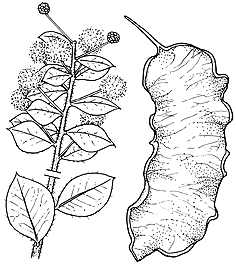Acacia piligera A.Cunn. APNI* Synonyms: Acacia undulifolia var. piligera (A.Cunn.) J.F.Macbr. APNI*
Acacia undulifolia (A.Cunn. ex Hook.) Maiden APNI*
Racosperma piligerum (A.Cunn.) Pedley APNI*
Acacia setigera A.Cunn. ex Hook. APNI*

Description: Obconical, open shrub to 1.5–2 m high, with branches ± erect or curving upwards, or sometimes extremities becoming pendent; branchlets terete to angled, brown, infrequently slightly pruinose, glabrous or sparsely hairy.
Phyllodes mostly rotated to 45–90o from the branchlet or sometimes ± coplanar with it, broadly elliptic or sometimes ± circular or occasionally broadly obovate, 0.9–3 cm long, 6–22 mm wide, grey-green to green, sparsely hairy or glabrous with hairs confined to pulvinus or extending to the margins or midvein, midvein subprominent, lateral veins faint, margins prominent and slightly undulate or flat, base oblique and frequently asymmetric, apex obtuse with uncinate mucro usually < 2 mm long, sometimes acuminate or acute; 1 gland to 1/8 length of the phyllode or basal.
Inflorescences 1 in axil of often reduced phyllodes; peduncles 6–16 mm long, glabrous or sparsely hairy; heads globose, 20–32-flowered, 5–9 mm diam., yellow to deep yellow.
Pods mostly curved, 3–8.5 cm long, 16–30 mm wide, leathery to firm, glabrous, margins usually undulate; seeds transverse; funicle filiform.
Flowering: throughout year.
Distribution and occurrence: in the upper Hunter Valley southwards towards the Hunter Range. Grows in woodland, usually in well-drained stony sandy loam, also cleared and disturbed areas.
NSW subdivisions: NC, CWS
Previously confused with Acacia uncinata. Similar to A. sertiformis but distinguished by non-pruinose branchlets, obtuse but not truncate or cordate phyllode bases and generally more erect habit. The name may allude to the downy appearance of the plant.
Text by P.G. Kodela
Taxon concept: P.G. Kodela & G.J. Harden, Flora of NSW Vol. 2 (2002); B.J. Conn & T.M. Tame, Australian Systematic Botany 9(6): 827-857 (1996)
APNI* Provides a link to the Australian Plant Name Index (hosted by the Australian National Botanic Gardens) for comprehensive bibliographic data
***The AVH map option provides a detailed interactive Australia wide distribution map drawn from collections held by all major Australian herbaria participating in the Australian Virtual Herbarium project.
|


